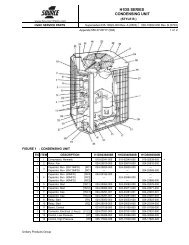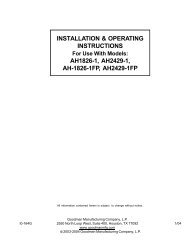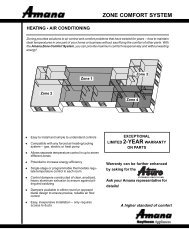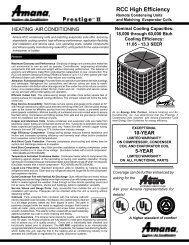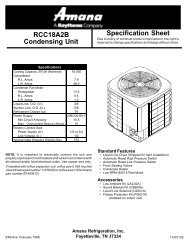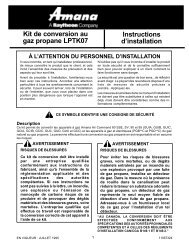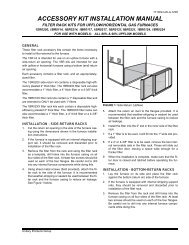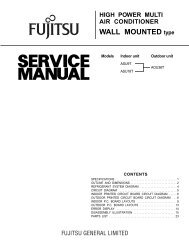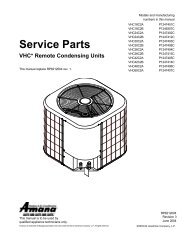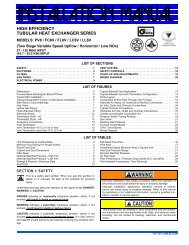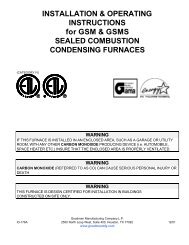Y-IM, BQ240 Sunline 2000 Single Package Heat Pump
Y-IM, BQ240 Sunline 2000 Single Package Heat Pump
Y-IM, BQ240 Sunline 2000 Single Package Heat Pump
You also want an ePaper? Increase the reach of your titles
YUMPU automatically turns print PDFs into web optimized ePapers that Google loves.
66394-Y<strong>IM</strong>-D-1004<br />
Should a freezestat open three times within two hours<br />
of operation, the UCB will lock-out the associated compressor<br />
and flash a code (Table 20). If the other compressor<br />
is inactive, the condenser fans will be deenergized.<br />
LOW AMBIENT COOLING<br />
To determine when to operate in low ambient mode,<br />
the UCB has a pair of terminals connected to a temperature-activated<br />
switch set at 30°F. When the low ambient<br />
switch is closed and the thermostat is calling for<br />
cooling, the UCB will operate in the low ambient mode.<br />
Low ambient mode operates the compressors in this<br />
manner: 10 minutes on, 5 minutes off. The indoor<br />
blower is operated throughout the cycle. The 5-minute<br />
off period is necessary to defrost the indoor coil.<br />
Low ambient mode always begins with compressor<br />
operation. Compressor minimum run time may extend<br />
the minutes of compressor operation. The defrost cycle<br />
will begin immediately following the elapse of the minimum<br />
run time.<br />
When operating in low ambient mode, the UCB will not<br />
lockout the compressors due to a freezestat trip. However,<br />
a freezestat trip will de-energize the associated<br />
compressor. If the call for cooling is still present at the<br />
end of the ASCD and the freezestat has closed, the<br />
unit will resume operation.<br />
SAFETY CONTROLS<br />
The unit control board monitors the following inputs for<br />
each cooling system:<br />
1. A suction line freezestat to protect against low<br />
evaporator temperatures due to a low airflow or a<br />
low return air temperature, (opens at 26 ± 5°F and<br />
resets at 38 ± 5°F).<br />
2. A high-pressure switch to protect against excessive<br />
discharge pressures due to a blocked condenser<br />
coil or a condenser motor failure, (opens at<br />
380 ± 10 psig and resets at 300 ± 10 psig).<br />
3. A low-pressure switch to protect against loss of<br />
refrigerant charge, (opens at 7 ± 3 psig and resets<br />
at 22 ± 5 psig).<br />
The above pressure switches are hard-soldered to the<br />
unit. The refrigeration systems are independently monitored<br />
and controlled. On any fault, only the associated<br />
system will be affected by any safety/preventive action.<br />
The other refrigerant system will continue in operation<br />
unless it is affected by the fault as well.<br />
The unit control board monitors the temperature limit<br />
switch of electric heat units and the temperature limit<br />
switch and the gas valve of gas furnace units.<br />
COMPRESSOR PROTECTION<br />
In addition to external pressure switches, the compressors<br />
also have inherent (internal) protection. If there is<br />
an abnormal temperature rise in a compressor, the protector<br />
will open to shut down the compressor. The UCB<br />
incorporates features to minimize compressor wear<br />
and damage. An Anti-Short Cycle Delay (ASCD) is<br />
utilized to prevent operation of a compressor too soon<br />
after its previous run. Additionally, a minimum run time<br />
is imposed any time a compressor is energized.<br />
The ASCD is initiated on unit start-up and on any compressor<br />
reset or lock-out.<br />
FLASH CODES<br />
The UCB will initiate a flash code associated with<br />
errors within the system. Refer to UNIT CONTROL<br />
BOARD FLASH CODES Table 20.<br />
RESET<br />
Remove the call for cooling, by raising thermostat setting<br />
higher than the conditioned space temperature.<br />
This resets any pressure or freezestat flash codes.<br />
HEATING SEQUENCE OF OPERATIONS<br />
WITH ELECTRIC HEAT<br />
When the thermostat calls for the first stage of heating,<br />
the low voltage control circuit is completed between “R”<br />
and “W1”. This 24vac signal is passed through the UCB<br />
to the RW1 Relay. Contacts RW1-2 open, assuring the<br />
reversing valve cannot be energized, except during<br />
defrost. Contacts RW1-1 close, completing the circuit to<br />
Y on the Defrost Control (DC). After its five minute<br />
ASCD timer is satisfied, the DC closes its internal compressor<br />
relay contacts, sending a 24vac signal to the<br />
MV1 relay. Contacts MV1-1 close sending a 24vac signal<br />
to the MV terminal of the UCB. If its ASCD timer is<br />
satisfied the UCB will energize compressor #1 and #2<br />
contactor M1. After a two second delay, it then energizes<br />
compressor #3 and #4 contactor M2. Therefore,<br />
on a call for heat from W1, both sets of compressors<br />
are always energized, unless one or the other is locked<br />
out by the UCB. Also on the call for heat, the DC energizes<br />
the M4 and M5 contactor which brings on both<br />
condenser fans.<br />
36 Unitary Products Group



